If you’ve stopped in Glen Park at 7 pm and heard the haunting strains of a trumpet and wondered where they came from, it’s Geoffrey Gallegos playing on his front steps over on Congo Street.
He’s been playing almost every night since early April to honor essential workers — teachers, grocery clerks, public transit employees, physicians, sanitation workers — each of whom has helped us through the current catastrophe that so far has the killed at least 165,000 Americans.
July 21’s performance by the San Francisco-born musician was like many before. He stood on his boyhood front porch and tuned-up for another unaccompanied performance. After greeting a group of 10 socially-distanced and seriously spread out neighbors, he let loose with “My Way,” a Frank Sinatra 1960’s standard.
“This seems appropriate,” he said.
After all, he’s been performing ‘his way’ over 100 times going on six months.
Gallegos first picked up a trumpet as a nine-year-old while attending Glen Park Elementary School.
“I was four when we moved to Congo Street from Noe Valley and was in the fourth grade when I began playing the instrument,” he told the Glen Park News by telephone the next day.
Geoffrey Gallegos would go on to burnish his musical chops by becoming Music Director and Conductor of Golden Gate Philharmonic in 2001 and Artistic Director and Principal Conductor of the San Francisco Youth Orchestra in 2018.
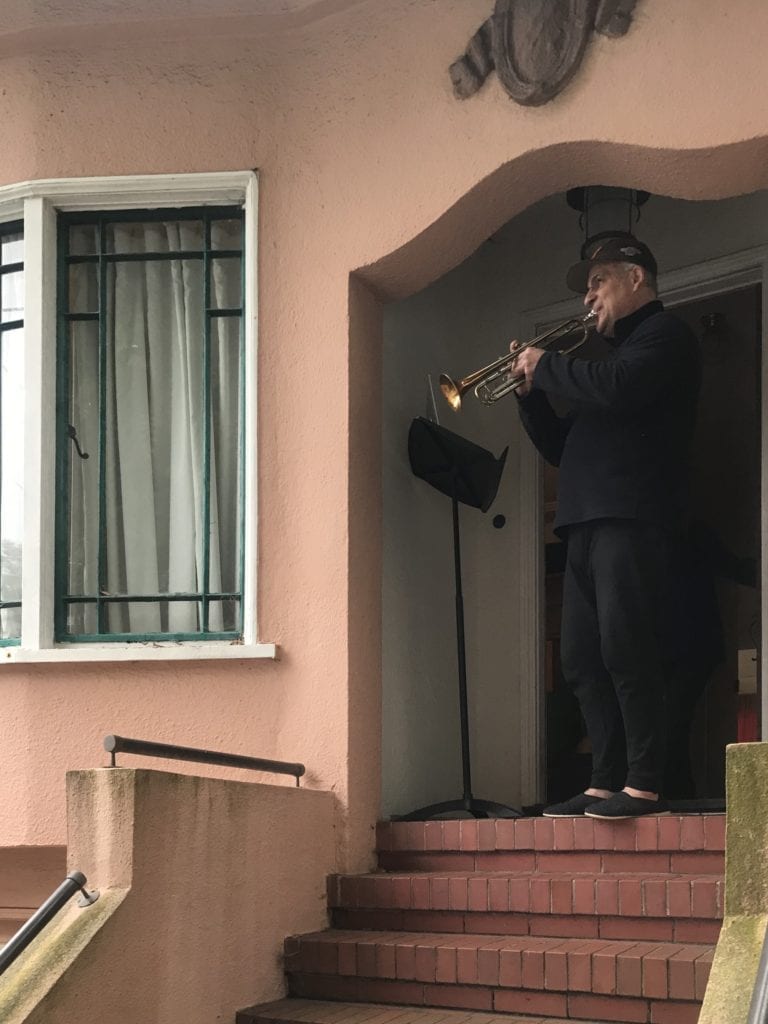
Dressed in a black sweater and blue jeans on July 21, he was announced by Dave Stout, a neighbor. Stout lives at the Stillings Avenue corner and makes a ritual of banging on a pot each evening, alerting neighbors that Gallegos’s performance is only moments from beginning.
Christophe Pouchard, a front-line Laguna Honda Hospital Administrative nurse, lives directly across the street from Gallegos. He listened, then observed that the 1969 Sinatra song actually has French origins.
Gallegos responded yes, explaining the music owed a debt to “Comme d’habitude,” composed and written by French songwriter Claude Francois.”
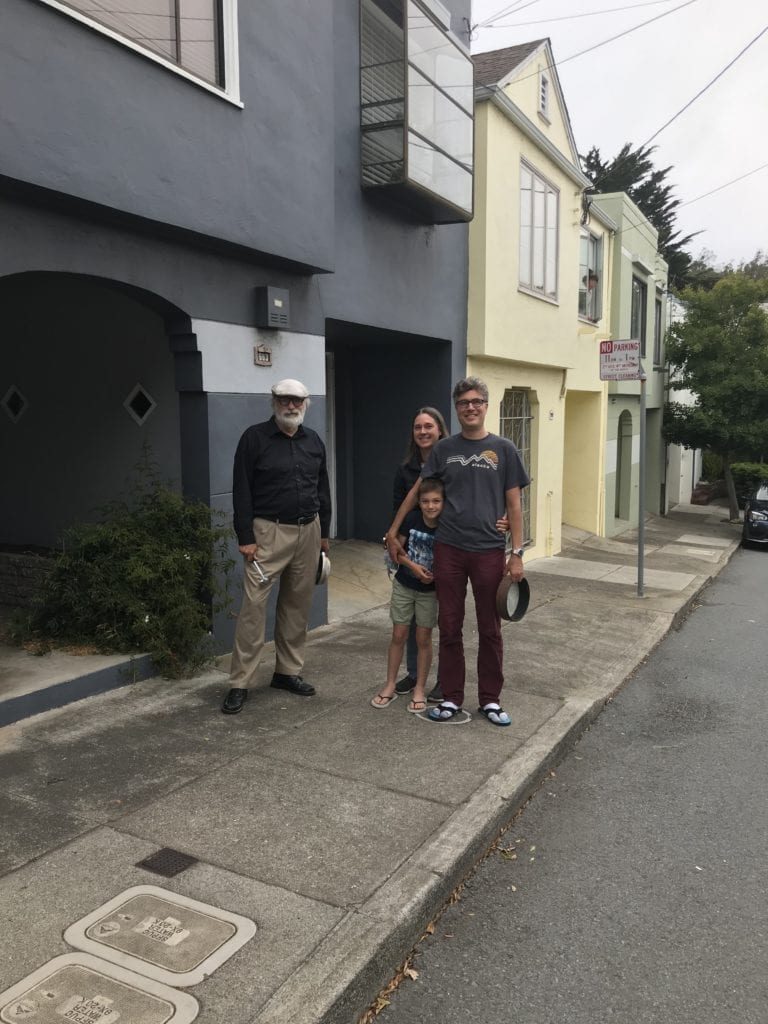
Pouchard emigrated from a hilly province in France and challenges vertiginous Stillings Avenue to Teresita Blvd, then following it to Portola Drive and down to Laguna Honda Hospital and Rehabilitation Center each morning where he keeps COVID-19 at bay. He, his wife and son moved to Congo Street in 2010.
Rehana Abbas, another Gallegos neighbor, who lives only doors from the Ponchard, chimed in.
“In March, I emailed neighbors a Congo Street spread sheet,” she told the Glen Park News. “It has brought us out each evening to thank workers such as Christophe.”
“We began by banging a drum and ringing bells in support of essential workers,” she said. “A few days later, Geoffrey volunteered to start serenading us each night with musical selections.”
“When someone on our block has a birthday, Geoffrey entertains us with “Happy Birthday.” He played a beautiful “Bolero” in honor of Bastille Day, and when I told him I loved “Hamilton,” he did the King George III parts. And when Mary Ann lost her mother last week, he performed Leonard Cohen’s “Hallelujah.”
Gallegos has showcased over 100 selections from the Great American Songbook, renditions of jazz, blues and folk, as well as music from the classical and operatic canon. Neighbors as well as strollers have been treated to the likes of Gershwin, Kern, Porter, Lennon and McCartney, Simon and Garfunkel, Rodgers and Hammerstein, Ellington, Ravel, Dvorak and Bizet.
“The silver lining in all of this,” said Abbas, “is while we’re sheltering-in-place Geoffrey’s real-time trumpet allows us to experience life not just zoom it.”
“Best of all,” she was quick to add, “he takes requests.”
Gallegos’s notes even waft down the hill, across Bosworth Street, along Chenery Street and up to the top of Mizpah Street where they’re experienced by Evelyn Rose and her neighbor Ashley Hathaway.
Hathaway first heard Gallegos from afar in mid-April.
“The question then became, ‘Who is this person and where is he playing?’” Hathaway emailed. “My husband, Tim, and I pondered this for several weeks.”
They began exploring, thinking early on the music emanated from Glen Canyon’s softball field.
“The mystery was spontaneously solved one night in mid-June,” she wrote.
The couple was returning from Joost Avenue, cresting Congo Street, then about to dogleg down its steep 700 block to Bosworth when Hathaway experienced her epiphany.
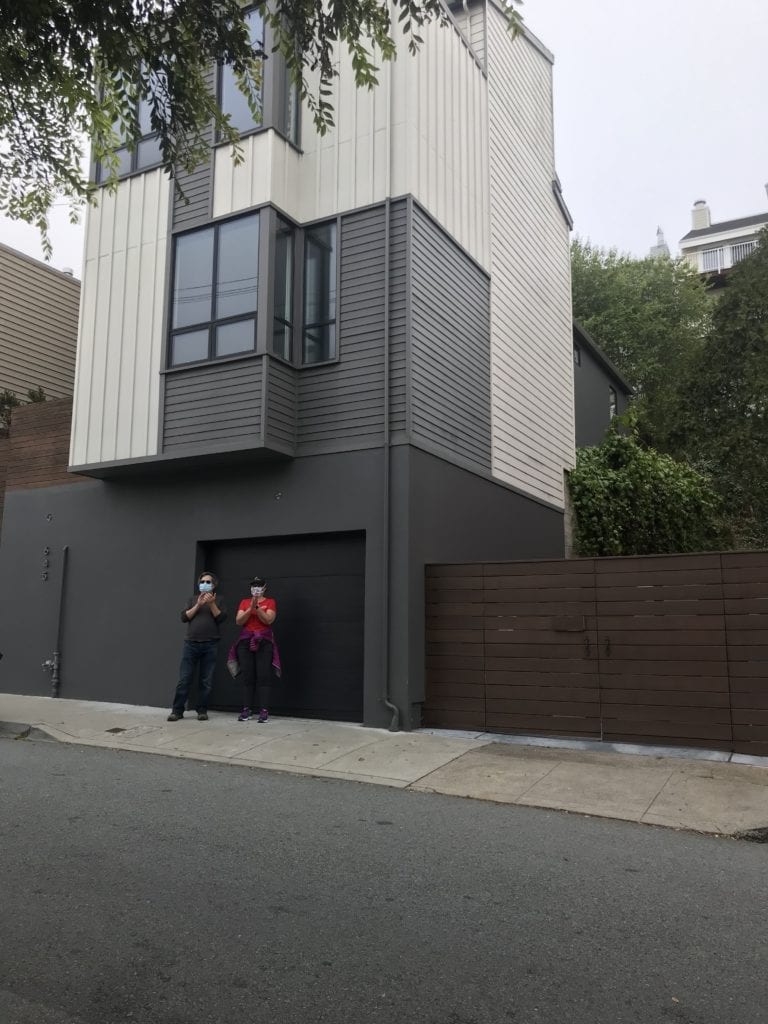
“At exactly 7 p.m. we drove right by Geoffrey,” she said. “In a split second I was able to lean out the car window with an enthusiastic hand wave and shouted, ‘No way, it’s YOU! THANK YOU, Trumpet Man!’”
“We found him! It was a glorious moment,” she said. “and one of the first things I thought in that moment was I need to write a story about this guy.”
Hathaway, who is a Glen Park News reporter, found herself too busy to pen her own piece and was pleased to learn the article would go to press under a different byline. But not too busy to acknowledge Gallegos’s contribution by leaving a handwritten thank you note at this house.
“We quickly realized that this was likely part of the ‘movement’ happening across the country – people making various kinds of noise in the early evenings to acknowledge health care workers and other front-line workers during this health crisis.”
Hathaway has made the trek to Congo Street’s 600 block for evening entertainment, but she said this summer’s cold and windy weather precluded her from making the hike more than a few times, preferring instead to remain in her back yard under her patio heater with a glass of wine.
“After a couple of visits to watch Geoffrey, I decided to deliver the personal note to his doorstep on the afternoon of July 6,” she said. “That was also the day Ennio Morricone had passed away. In my note I thanked Geoffrey for his gift of nightly music and for sharing his talents with all of us. I also requested he play a tribute to Morricone, and that evening my request was granted.”
“A few days later I received a wonderful hand-written note in my mailbox from Geoffrey and since then we’ve exchanged several emails,” she said. “I frequently send him requests and he indulges me if it’s a tune he hasn’t played.”
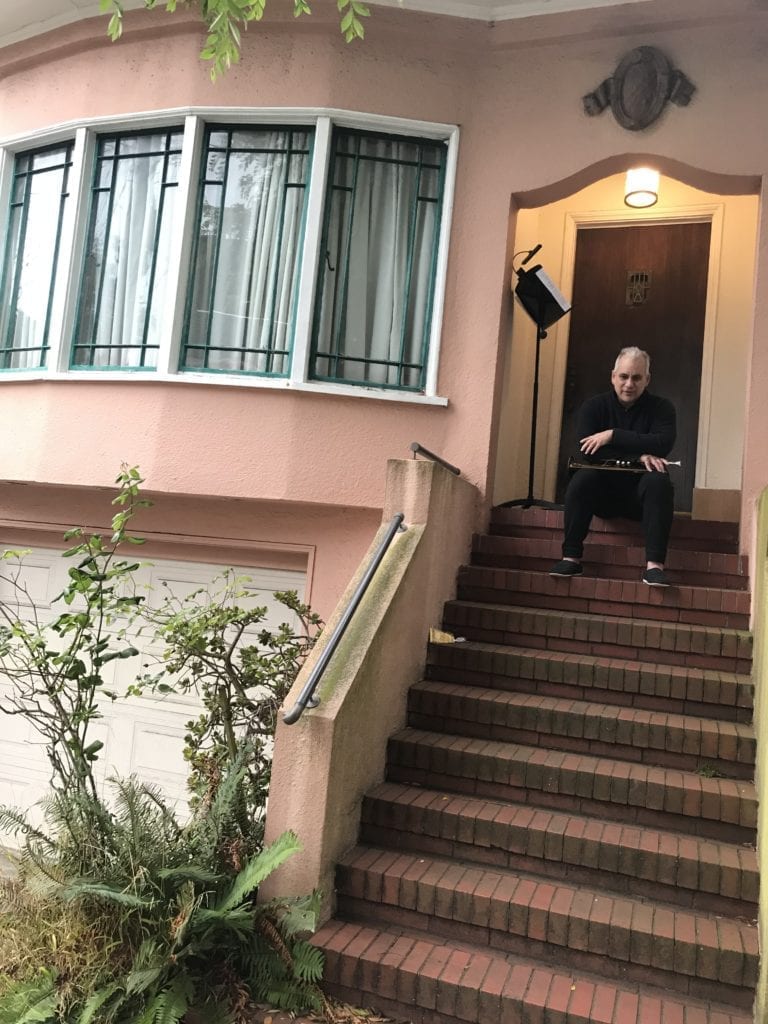
Meanwhile, Hathaway’s neighbor, Evelyn Rose, director and founder of the Glen Park Neighborhoods History Project, gave some history background about the north side of Martha Hill. The hill was named after early resident and suffragette Ada Parker Stillings’s husband, Calvin’s grandmother.
And, like Hathaway, she hasn’t been shy about communicating with Gallegos.
“We love how your trumpet echoes over us on Mizpah,” she emailed him on July 28, “and how incredible that it’s coming all the way over the southern portion of Glen Canyon from Congo Street.”
Rose can even go an extra block or two, spinning how Congo Street might have been named. The tale centers around explorer Henry M. Stanley finding David Livingston deep in the heart of Africa.
In December 1890, Rose emailed the Glen Park News, Stanley came to San Francisco and presented a lecture about his experiences in the Congo, returning in March 1891 for a lecture in Oakland that was attended by 3,000 people.
Stanley’s wife was friendly with a host of San Francisco swells who summered in Menlo Park to escape the Nob Hill fog. Among the City elite were the Stanfords, Hopkins and Athertons.
Matters developed quickly after that. A month later, in April 1891, 200 acres of the San Miguel Ranch was purchased from Leland Stanford by the Sunnyside Land Company, wrote Rose. Behrend Joost, who’d acquired his wealth by investing in a dredging company during the French construction of the Panama Canal in the early 1880s, went on to build the San Francisco-San Mateo Electric Railway connecting the new Sunnyside residents to downtown San Francisco.
“Given his wealth, it would not be out of the question that Joost may have met Stanley,” said historian Rose. “This is pure speculation but with Joost, a native of Germany and aware that it had become a leading developer in the Congo region, it may have elicited the idea to name a Sunnyside street ‘Congo.’”
What about Glen Park’s side of Martha Hill? Gallegos’s neighbor Rehana Abbas has her take.
“Try walking up Congo Street when you’re 36 weeks pregnant,” she said.
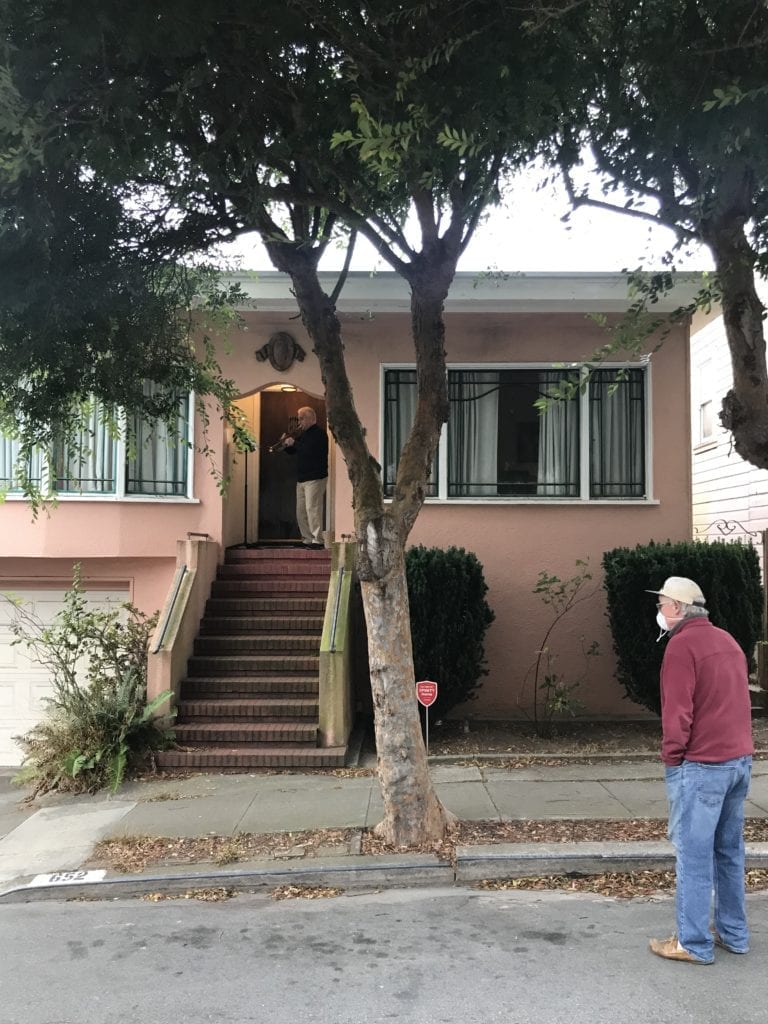
In the Gilded Age, according to Rose, the only sounds coming from Martha Hill were the crowing of Glen Park roosters and the mooing of Sunnyside cows, certainly not sonorous melodies from Broadway songs such as Richard Rodger’s “Some Enchanted Evening,” or a symphonic movement such as “Going Home” from Antonin Dvorak’s “New World Symphony.”
Both now exist, courtesy of impresario Geoffrey Gallegos who is convinced his brass soliloquies can push back on the dark days of August, which have now seen a surge in Bay Area Covid-19 infections.
Maestro Gallegos’s after-school youth orchestra, which has influenced over 2,000 students since it began in 1995, gave it last performance at Lakeside Presbyterian Church on March 3, two weeks before the sour notes of the virus stymied further recitals and sent San Francisco into lockdown and mask up.
With a present that is problematic, a future that may be fragile, Gallegos finds himself
returning to a past that is salutary.
He recalls a boyhood when Congo Street was a conduit between Monterey Boulevard and Bosworth Street.
“My mother would stand on our backyard deck and watch me walk to Glen Park Elementary, which was institutional grey then,” said Gallegos, who has spent 10 years as Artist in Residence at the Ruth Asawa School of the Arts.
“By the sixth grade I was lugging instruments back up the Congo Street hill,” he said.
As a 12-year old, Gallegos free ranged beyond Glen Park, traveling to the Mission District in pursuit of music lessons, as well as riding Muni to study at the San Francisco Conservatory of Music Preparatory school.
“I’d walk to Mission Street after school and catch one of the busses to Capp Street and attend the Community Music Center,” he told the Glen Park News.
He took advantage of opportunities to attend San Francisco Opera rehearsals where his father, Ronald Gallegos, sang the role of El Dancairo in a 1962 Kurt Herbert Adler/ Marilyn Horne performance of “Carmen.”
But it was the neighborhood public school that played a pivotal role in his performance development.
“Mr. Parenti was a rotating school district music teacher,” said Gallegos, who would later attend Aptos Junior High School and then Lowell High School. “There were 10 or 12 kids in the band and it was my first ensemble experience.”
“Dolores Tighe was another music instructor and the class put on a truncated performance of the opera “Hansel and Gretel,” he remembered. “It was my first experience performing publicly and it was remarkable.”
At Aptos, teacher Joan Murray, who founded the Golden Gate Philharmonic, assembled a string orchestra that became another of his artistic benchmarks.
“It solidified my interest while simultaneously allowing me to see the possibility of conducting” said Gallegos, who, earned a Bachelor of Music in instrumental conducting at San Francisco State University. He went on to receive a Master of Arts degree and served as the Conductor of the University Chamber Orchestra.
On July 23, two days after covering Old Blue Eye’s signature song, Gallegos gained his steps once again. Still dressed in dark clothes, he donned a Giants baseball cap.
“The hat’s a little bit of a giveaway,” he announced, segueing into a rendition of “Take Me Out to the Ballgame,” a not too subtle clue that it was opening day of an abbreviated MLB season.
Next, he performed a rendition of Dvorak’s “Humoresque,” composed by the Czech in 1892. The piece had been requested by a neighbor.
Finished, he schooled those gathered with a bit of Hollywood trivia, revealing to his zipped-up audience that in the film “Humoresque,” John Garfield’s solo pieces were performed by Isaac Stern.
Then, on August 3, as the City, citing a “major resurgence,” prepared to add some 93 beds in a makeshift Presidio facility for non-COVID-19 patients thus clearing hospital beds for infected patients, he again looked out at listeners who that evening numbered fewer than a half a dozen.
A couple, wearing masks, stood across Congo Street while a septuagenarian ambled up from Stillings Avenue and Nordhoff Street. It was a cold evening. Neighbors remained inside; some looking through front windows.
“Over the last week or so, knowing people are staying-in-place. I’ve embarked on a cross country road show of tunes,” he explained to a fleeced and puffy coated audience.
Over that time Gallegos has played “Viva Las Vegas,” “Route 66,” and “On the Trail” from the “Grand Canyon Suite.”
“So, we’re going to travel to New Mexico,” he said. “O Fair New Mexico” is the state’s official song.”
Gallegos wasn’t through, though.
“The writer of the song was Elizabeth Garrett, the daughter of lawman Pat Garrett who shot Billy the Kid in 1881,” he said, endearing himself for all time to antiquarian Evelyn Rose.
When he’s not playing Geoffrey Gallegos has had ample time to reflect.
“There’s not an orchestra in the country that hasn’t undergone a systemic change over the last several months and live performances, at least for a while, are not happening,” he offered. “In this moment, it’s kind of an irony that sheltering-in-place has actually brought us closer.”
“Even with neighbors who don’t come out to listen there’s now a greater awareness of one another,” he said, “And picking up the trumpet again, well, playing has been fun.”
“Besides, at 7 p.m., before all this difficulty I’d be driving to rehearsal,” he said. “Now I look forward to these evenings that can bring a little cheer.”
“I’ll keep blowing,” he emailed on August 8, visualizing extending his road trip farther east to the ‘Show me State.’ “Tonight, a little “St. Louis Blues” ala John Handy and Louis Armstrong.”
“I believe what Geoffrey is doing goes far beyond acknowledgement of front-line workers and the current health crisis,” Ashley Hathaway said. “It’s a beautifully profound way for him to share his passion for music, to renew and refresh his connection to playing the trumpet, all the while doing something creatively positive for himself and others around him,”
Martha Hill to her back, back in the safety of her home she harmonized a final lyric.
“Geoffrey is shedding lots of beautiful light on one of the darkest most challenging times in our history,” she said. “What a gift.”